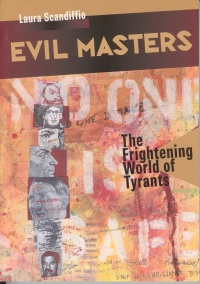| ________________
CM . . .
. Volume XII Number 1 . . . .September 2, 2005
excerpt:
In a brief introductory chapter entitled "Ways of the tyrant," Scandiffio outlines the characteristics of tyrannical rulers: they usually come to power at a time of turmoil, they are masters of propaganda that is especially effective when there is no opposition to contradict it, they strive to change the way people think and pay special attention to the younger generation, they back up their orders with another tool—terror, they often show signs of xenophobia, and the longer he is in power, the more suspicious a tyrant becomes. She also explore some psychological traits and formative events that tyrants often have in common: many of them were brutalized in childhood, in their youth, many were rejected by a group they admired and longed to join—a school or profession, a social class, or the military, and these future tyrants secretly kept a sense of their own special destiny. The bulk of the work is devoted to profiles of seven tyrannical leaders, arranged chronologically and beginning with Qin Shi Huangdi, the first emperor of a unified China, who lived around 259-210 BCE. Also featured are Nero, Roman Emperor who lived 37-68 CE, Ivan the Terrible, Czar of Russia who lived 1530-1584, Maximilien Robespierre of France who lived 1758-1794, Adolf Hitler of Germany who lived 1889-1945, Josef Stalin of the Soviet Union who lived 1879-1953, and Iraq's Saddam Hussein who was born in 1937 and overthrown in a U.S.-led invasion in 2003. Five additional dictators from the last fifty years are briefly noted with one-page entries. Scandiffio starts each profile by recounting an incident from the tyrant's reign, followed by a historical account of the subject's life with an emphasis on his rise to power, brutal rule, and ultimate demise. The main profiles can stand on their own as historical biographies, but readers will appreciate the accounts more fully if read in conjunction with the introductory chapter. In the later chapters, Scandiffio often points to similarities between subjects and notes how earlier tyrants often served as role models for later ones. In a very brief concluding chapter on ending tyranny, Scandiffio touches upon some of the complex issues facing international bodies such as the UN and the International Court of Justice in their attempts to deal with brutal dictators. Black and white maps, portraits, and illustrations of average quality are often included with sidebar information that is separated from the rest of the narrative by the use of a different type font and a gray background. Unfortunately, the gray background is graduated from dark to light, and it is sometimes difficult to quickly determine where the sidebar begins and ends. The designer could have used solid gray backgrounds and scrapped the distracting solid lines that run across the bottom of every page. The information in the sidebars sometimes lists facts or provides a chronology, but it often includes summaries outlining political structures or cultural information that will help readers to understand historical events in a society different from their own. Carefully chosen quotations by or about the subjects appear in the margins and reinforce the thrust of the text. Given the intended audience, Scandiffio does not use footnotes, but she does include a one-page bibliography of main sources as well as a list of juvenile titles for further reading that includes one to three fairly recent titles on each of the main subjects. A glossary will be of value to younger readers in particular. A fairly detailed index is a useful addition. In general, Scandiffio, a Toronto-based editor and children's author, delivers an informative and interesting text. However, the uninspiring cover and book design will not likely appeal to casual readers. Recommended with reservations. Val K. Lem is a catalogue librarian and subject liaison for history, English, and Caribbean studies at Ryerson University in Toronto, ON.
To comment
on this title or this review, send mail to cm@umanitoba.ca.
Copyright © the Manitoba Library Association. Reproduction for personal
use is permitted only if this copyright notice is maintained. Any
other reproduction is prohibited without permission.
NEXT REVIEW |
TABLE OF CONTENTS FOR THIS ISSUE
- September 2, 2005.
AUTHORS |
TITLES |
MEDIA REVIEWS |
PROFILES |
BACK ISSUES |
SEARCH |
CMARCHIVE |
HOME |
